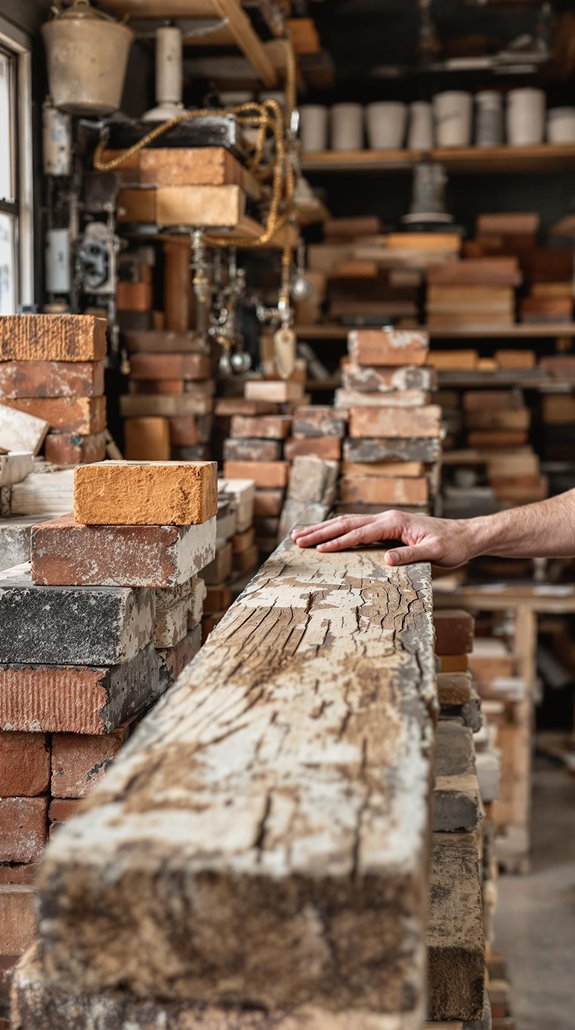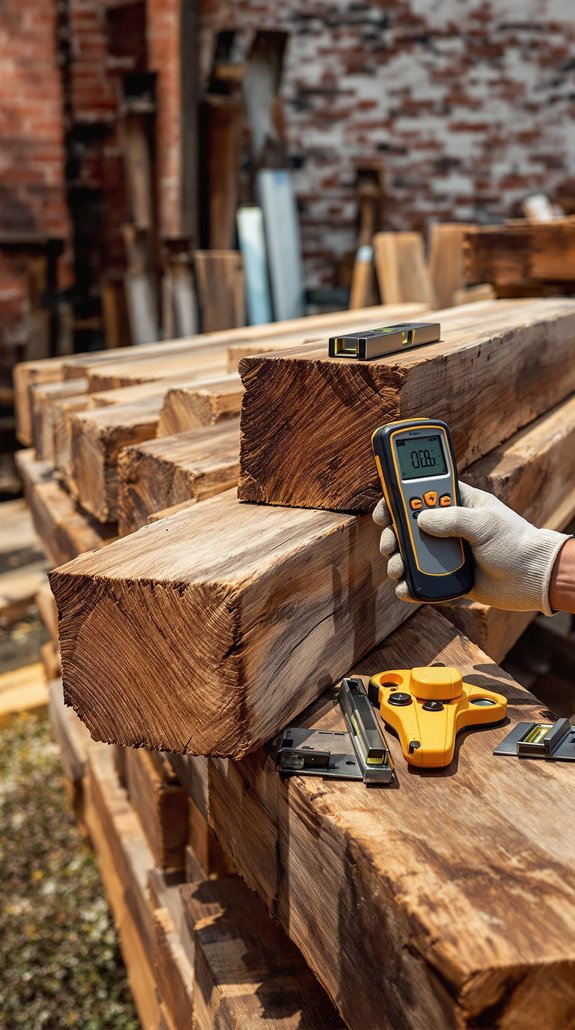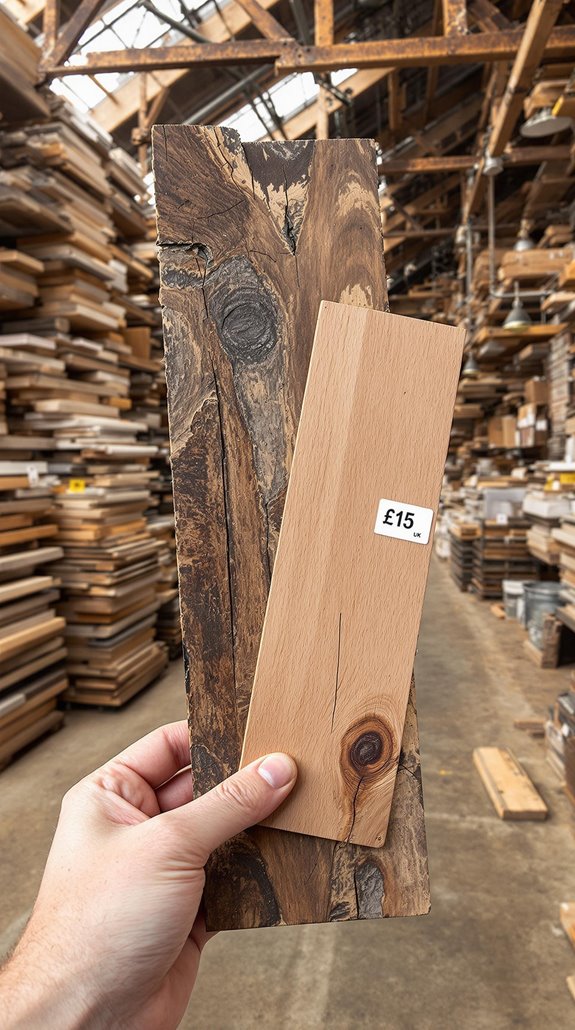I’ve discovered that sourcing reclaimed materials for UK renovations requires a strategic approach that goes far beyond simply visiting the nearest salvage yard. Through my experience managing sustainable construction projects, I’ve learned that successful material recovery depends on understanding quality assessment techniques, building regulation compliance, and establishing relationships with verified suppliers. The process involves specific challenges that can make or break your renovation timeline and budget, but there’s a systematic method that consistently delivers results.
Key Takeaways
- Use FutuREuse directory or Salvo’s Material Reuse Portal to find over 100 verified UK reclamation yards by location and material type.
- Conduct thorough visual inspections and non-destructive testing to assess structural integrity, moisture content, and compliance with current British Standards.
- Ensure reclaimed materials meet UK Building Regulations, particularly Part L for CO2 reduction and require third-party assessments for UKCA marking.
- Implement hybrid storage solutions combining on-site space with off-site warehousing, plus route optimization to reduce transportation costs by 30%.
- Target smaller renovation projects where sourcing effort is manageable, as reclaimed materials cost 20-25% less than new equivalents.
Understanding the Environmental Benefits of Reclaimed Materials in UK Construction

The magnitude of construction waste in the UK presents a stark reality: our industry generates over 50% of the nation’s 220 million tonnes of annual waste, with 4.4 million tonnes destined for landfills. When I choose reclaimed materials for your renovation, I’m directly addressing this crisis while delivering tangible environmental benefits.
You’ll reduce carbon emissions considerably since construction accounts for 25% of UK greenhouse gas emissions. Reclaimed materials require 30-50% less energy to process than manufacturing new equivalents, cutting your project’s embodied carbon footprint. The most significant emissions reductions occur because concrete and steel manufacturing represents the largest source of CO2 in construction projects. Additionally, using reclaimed materials can enhance your home’s energy efficiency by improving insulation without the need for new resources. I’m also helping preserve virgin resources like clay and limestone by reducing quarrying demand.
Your renovation becomes part of the circular economy, extending material lifespans while supporting our collective Net Zero 2050 targets. It’s practical environmental stewardship that delivers real results.
Identifying Reliable Suppliers and Reclamation Yards Across the UK
Finding dependable suppliers transforms your sustainable renovation from concept to reality, requiring strategic research beyond basic online searches. I recommend starting with thorough directories like futuREuse, which lists 100+ verified reclamation yards searchable by material type, and Salvo’s Material Reuse Portal for location-based searches.
For specialized needs, I’ve found material-specific suppliers deliver superior results. London Reclaimed Brick Merchants offers extensive brick variety across London and the Home Counties, while Britannia Stone provides Yorkshire-sourced reclaimed stone. For timber, Reclaimed Ltd specializes in international sourcing for flooring and cladding. Additionally, sourcing reclaimed materials can significantly reduce potential property damage associated with new construction methods.
Regional social enterprises like Community Wood Recycling and Oxford Wood Recycling offer environmentally conscious alternatives while supporting community job creation. Many suppliers also offer price match guarantees to ensure competitive pricing across their reclaimed materials. These suppliers guarantee authenticity through meticulous deconstruction and grading processes, making your renovation both sustainable and structurally sound.
Evaluating Quality and Structural Integrity of Salvaged Building Materials

Once you’ve identified reliable suppliers, rigorous quality assessment becomes your next critical checkpoint—I’ve learned that thorough evaluation prevents costly structural failures and regulatory complications down the line.
I start with visual inspections, checking for cracks, warping, pest damage, and corrosion. For timber, I measure moisture content below 18% using hygrometers and verify dimensional stability within 1mm per 300mm length. Non-destructive testing like ultrasonic gauging reveals hidden defects in steel components. It’s also important to consider that regional price variations can affect the overall cost of these materials.
Material-specific standards matter: reclaimed timber must meet BS EN 14081 grading, while recycled steel requires BS EN 10080 certification. I always screen for hazardous substances—asbestos in pre-2000 structures and lead paint from pre-1992 buildings. This screening process is essential since recycled materials help reduce waste and minimize demand for new resources.
Finally, I engage structural engineers for load calculations and obtain third-party certifications, ensuring building control approval.
Navigating UK Building Regulations and Compliance Requirements for Reused Materials
While structural integrity forms the foundation of material selection, steering through UK building regulations transforms compliant reuse from aspiration into legal requirement—I’ve witnessed projects halted mid-construction when teams overlooked compliance documentation for reclaimed components.
I’ll guide you through the essential compliance framework. Part L mandates 30% CO2 reduction documentation, while Part B prohibits combustible materials in external walls over 18m height. When repurposing spaces, Regulation 6 triggers compliance requirements for reclaimed materials meeting current standards. Understanding the cost structures associated with legal compliance can help manage overall project expenses.
You’ll need third-party conformity assessments for UKCA-marked reclaimed materials, plus photographic evidence throughout construction. Materials from pre-1990 buildings require hazardous substance testing before reuse. Structural elements need recertification to Part A standards for load-bearing applications.
Documentation tracing materials to source projects guarantees regulatory compliance and project success. Building regulations are updated frequently throughout the year, making continuous awareness of changes essential for maintaining compliance with reclaimed material standards.
Cost Analysis: Comparing Reclaimed Materials to New Construction Products

Beyond regulatory compliance, the financial reality of reclaimed materials demands careful analysis—I’ve seen renovation budgets swing dramatically based on material sourcing decisions that seemed minor during planning stages.
Reclaimed materials typically cost 20-25% less than new equivalents, delivering immediate savings while avoiding increasing UK landfill taxes. However, sourcing requires significant effort that works better for smaller projects where character adds property value. Improving thermal efficiency can further enhance the benefits of using reclaimed materials.
For larger renovations, I recommend combining new and reclaimed materials strategically. Only 1% of construction projects currently use reclaimed materials, indicating untapped market potential. The energy savings alone make recycled materials compelling, as recycled steel uses up to 75% less energy than producing new steel.
Long-term financial implications favor reclaimed options through reduced maintenance costs and 14-19% operational savings from energy-efficient designs. Quality recycled materials meeting British Standards often outlast cheaper new alternatives, making initial sourcing investment worthwhile for sustainable renovations.
Essential Tools and Techniques for Assessing Reclaimed Material Suitability
The success of any reclaimed material renovation hinges on thorough assessment before purchase—I’ve witnessed projects derail when contractors discovered structural defects or contamination after materials arrived on-site. I start with visual inspections, checking for cracks and deterioration patterns that compromise structural integrity. Non-destructive testing, particularly sound speed propagation, reveals hidden flaws without damaging materials. I measure dimensional accuracy against project specifications and verify colour consistency for aesthetic compatibility. Incorporating innovative lighting design can further enhance the overall appeal of reclaimed materials in your renovation.
For load-bearing applications, I conduct destructive testing on sample pieces to validate capacity. Chemical analysis identifies hazardous substances like asbestos or lead paint. I classify materials by reuse potential and assess collection feasibility. Creating material passports guarantees traceability—documenting origin, first-life application, and performance history. When evaluating reclaimed materials, I ensure they meet recycling definitions that exclude energy recovery and materials destined for fuels or backfilling operations. This systematic approach prevents costly surprises and guarantees reclaimed materials meet your project’s structural and safety requirements.
Storage and Transportation Logistics for Salvaged Construction Materials
Once you’ve validated your reclaimed materials through proper assessment, moving them efficiently from source to site becomes your next operational challenge. I’ll guide you through proven logistics strategies that fellow renovators rely on.
For storage, you’ll need hybrid solutions combining on-site space for daily materials with off-site warehousing for bulk items. Urban projects particularly benefit from this approach due to space constraints. Smart warehouses with IoT sensors prevent material degradation by monitoring environmental conditions.
Transportation requires eco-friendly methods and just-in-time delivery synchronized with your construction schedule. Specialized providers like Material Reuse offer circular-economy-aligned services, while route optimization reduces fuel costs by 30%. Online cataloguing systems help you track stored items, and AI-driven forecasting predicts your material needs, minimizing over-ordering and keeping your project on track.
Conclusion
I’ve outlined the essential steps for sourcing reclaimed materials in your UK renovation project. You’ll need to identify reliable suppliers through verified directories, conduct thorough quality assessments, and guarantee compliance with building regulations. Don’t forget to factor in storage and transportation logistics early in your planning. By following these technical guidelines and maintaining a project-focused approach, you’ll successfully integrate sustainable materials while meeting structural requirements and budget constraints.
References
- https://lubelska.co.uk/sustainable-materials-in-construction/
- https://www.gov.uk/government/statistics/uk-waste-data/uk-statistics-on-waste
- https://2050-materials.com/blog/constructing-a-more-sustainable-future-for-the-uk-economy/
- https://www.material-reuse.co.uk/the-most-valuable-reclaimed-materials-in-the-uk-construction-market/
- https://wastedirect.co.uk/guides/construction-waste-statistics/
- https://www.gardinersreclaims.co.uk/sustainable-construction-using-reclaimed-materials/
- https://awh.co.uk/2023/10/26/reduce-reuse-recycle-the-benefits-of-material-reuse/
- https://abc-home.co.uk/reclaimed-materials-sustainable-solutions-for-construction/
- https://reclaimedbrickcompany.co.uk/blogs/yard-display/sustainable-living-embracing-reclaimed-building-materials
- https://atlanticrecycling.co.uk/advantages-of-using-recycled-materials-in-construction-projects/

